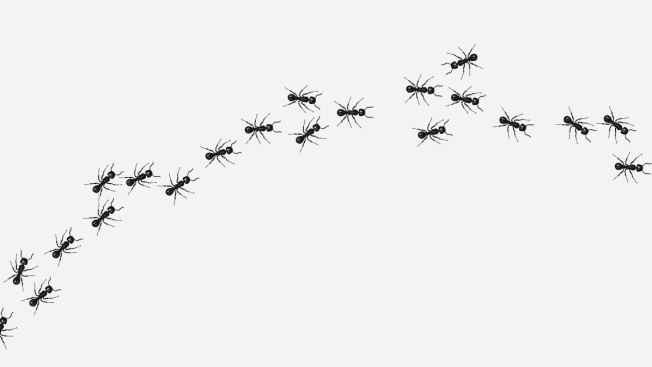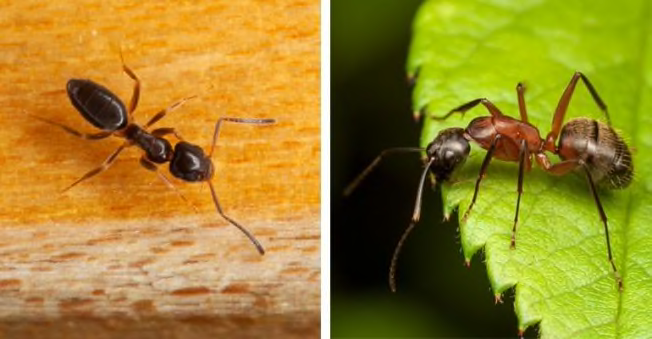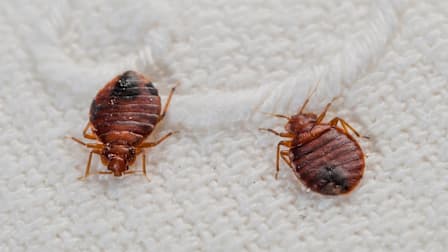How to Get Rid of Ants
These 6 simple steps will help keep them from marching into your home
When you shop through retailer links on our site, we may earn affiliate commissions. 100% of the fees we collect are used to support our nonprofit mission. Learn more.

Ants make for terrible houseguests. They come uninvited, get into everything, and are in no hurry to leave. But they’re also fairly easy to get rid of, or better still, avoid altogether.
Through the warmer months, the two types most likely to show up are house ants (technically known as odorous house ants because of the peculiar smell they release when crushed) and carpenter ants. When their natural habitat is destroyed because of development—such as construction on a new home, additions, or decks—ants seek out alternate food sources, which is what brings them indoors.
What Do Ants Want, Anyway?
To make someone happy or comfortable, it helps to understand what they want in the first place. Apply this logic to ants, but use reverse psychology: You need to know what they’re looking to gain from your living space so that you stop offering them a sanctuary. Ants aren’t trying to be annoying, they’re just trying to survive. Our homes are giant, well-stocked grocery stores for them—the ultimate sources of comfort and survival.
“Inadequate sanitation is the main factor contributing to ant infestations,” a representative from Orkin tells CR. “When dishes are left unwashed in the sink, food remnants linger on countertops, crumbs accumulate on the floor, and trash is not regularly disposed of, it creates a ready supply of food for ants on the lookout for meals. Foods that ants are attracted to are going to vary based on the ant species, time of day and/or year, and temperatures. Most ant species will eat sugars at times, but also fats, carbs, and proteins.”
Food isn’t the only thing ants crave. If you’re noticing more ants in your home after heavy rainstorms or periods of excessive dry heat, it’s not your imagination. Droughts and long periods of dry weather can bring ants into your home in search of water and food. Ants seek shelter from the rain, and they see our homes as the perfect dry, warm place to settle and protect their nests.
Identifying Ant Type Is Crucial
Identifying ants can be difficult due to their small size, according to Chad Gore, PhD, entomologist and market technical director for Terminix. But it’s crucial if you want to successfully ant-proof your home.
“To properly identify them often requires some level of magnification where you have to look at features on the exoskeleton, such as grooves, the number of segments in the antennae, and the number of nodes (like bumps on the waist) on the segment between the thorax and abdomen,” Gore says. “Some ants, like Pennsylvania carpenter ants, tend to be very large and black, which makes them fairly easy to recognize. There’s also some that, when squashed between fingers, have a very distinct odor. [Editor’s note: Leave this one for the experts to do.]
Just remember that all ants have elbowed antennae, a constricted waist, and either one or two nodes on that constriction. Also, when you see the reproductives with wings, they have two pairs with the hindwings shorter than the forewings. Proper identification of the ants that plague is very important. Not all ants are treated the same way from a control perspective. It’s best to get professional advice on your ant ID.”
Integrated Pest Management (IPM) is a science-based strategy to prevent ant invasions and handle ant problems without spraying harmful pesticides—and identifying the ant type in and around your home is the first step toward modifying your habitat and removing food sources that draw them into your living space. CR senior scientist Michael Hansen, PhD, a biologist and ecologist who wrote his doctoral thesis on integrated pest management, says different ant species crave different foods. For example, Argentine ants, which are found in southern states, California, and Hawaii, seek sweet foods and sometimes proteins and make their homes outdoors in shallow mounds.
But Carpenter ants, found throughout the U.S. and most common in the North, prefer sweets and nest in places like tree stumps and firewood, which means wood stored close to your home for your fireplace could be as much a culprit for their entry as sweet foods you’ve left out on the counter too long. If your sole solution is to run to the store and purchase a “sweet” tasting bait, you may or may not solve your ant problem, depending on the type of ants in your home and their specific cravings. “You have to know their biology to know what actions to take,” Hansen says.
How Do Ants Get Into Your Home?
All common pest ants are outdoors by nature and the only true indoor nesting ant is the Pharaoh ant, according to Orkin. Assuming the ants you typically get in your home aren’t Pharaoh ants, which have bodies that are nearly transparent and range in color from yellowish to light brown and red, how are the majority of these outside dwellers finding their way into your kitchen? All too easily, unfortunately. “Ants enter through cracks and crevices in the structure, around windows, through doors or openings in the foundation,” the Orkin representative says. “They will also use trees and other plants that touch the house to find an entry. Utility lines above and below ground are also avenues used by ants.”
Eradicating ants requires a one-two punch that includes sanitation and sealing up the foods they crave, as well as blocking their entry points to the best of your ability.

Photos: Alamy Photos: Alamy
How to Ant-Proof Your Home
Ant-proofing your home takes a combination of planning ahead and a commitment to daily cleaning habits. The best way to find out where ants are coming into your house (or if they have a colony in the walls of your house) is to set out a substance you know they really like—tuna fish in oil or a sugar substance can work—and then follow the trail back to where they are entering the room, Hansen says. You can then caulk up or seal those cracks.
But think twice before you grab a can of bug spray and start crop-dusting your kitchen countertops.
“Ant poison may make you feel like you’re accomplishing something, but you’re not,” says Hansen. “Unless you solve the problem of what’s attracting them to your house—and how they’re getting in—you should remember that there are thousands of ants in every colony, and you’ll just keep seeing them.”
With that pleasant thought in mind, we asked our pest management experts about the best way to get rid of ants. Here are their top six tips.
1. Keep Your House Clean
Ants feed on sugar, protein, and just about anything else they can find. “Generally, a colony will send out a few ants to scout—they’ll bring back a sampling of any food they find to the colony, and hundreds will follow them back into the house,” Gangloff-Kaufmann says. “And in my experience, they particularly gravitate toward sugary liquids.”
To keep scouts from returning with their friends in tow, quickly clean up spills, particularly honey, maple syrup, and soda. And keep all food in airtight containers.
2. Eliminate Damp Spots and Rotted Wood
“While house and carpenter ants generally form a primary colony outdoors, they’ll sometimes build satellite colonies inside a home to serve as a conduit for resources,” Gangloff-Kaufmann says. “And both species prefer damp areas.” That means showers, windows, and damp spots in the basement need extra attention.
Look for leaks, fix them quickly, and replace any water-damaged materials. “Unlike termites, which eat their way through new or old wood, carpenter ants will only tunnel through wood that’s already been damaged by water,” Gangloff-Kaufmann says.
One source of water-damaged wood to avoid? A deck. These structures will rot from neglect and function like a red carpet for carpenter ants. The best way to get rid of ants there is to keep your deck in tip-top shape. Below, we’ve highlighted two decking materials that are wood alternatives, as well as a top-rated wood stain to protect a wooden deck from further damage.
3. Set Ant Baits
“The most effective method for controlling an ant infestation is using ant baits. Set them out anywhere you see ants and expect a party,” Gangloff-Kaufmann says. “If you still see ants around the house, try a few different brands of baits until you find one that’s appealing to this particular colony.”
In addition to killing off any ants that feed on the sweet, sugary bait syrup, it kills larvae when scouts track the liquid back to the colony and helps control the population.
If you have pets, check the packaging carefully and be mindful of where you place ant baits.
4. Stay Away From Sprays
You might be tempted to apply a bug barrier spray around the foundation of your home to discourage entry, but Hansen doesn’t recommend it. For starters, the spray wears off and addresses only one potential source of entry for ants. But there’s even more to his advice.
“I’d argue that insect barrier sprays are both ineffective against ants and complete overkill,” Hansen says. “Worse, some of these sprays contain chemicals that are endocrine-disrupting compounds, which can alter our hormones. Similar compounds have been linked to neurobehavioral effects in children, including reduced IQ and increased rates of ADHD, even at the low levels you’d be exposed to when spraying your house.”
Sprays will indeed kill the worker ants you see in your home (but so will soapy water), which may give you a temporary feeling of accomplishment. But sprays won’t kill the queen ant, her colony, or her eggs. You’ll find yourself frantically running on what Hansen calls the “pesticide treadmill,” having to spray your space again and again without really making a dent in your ant problem.
If you still aren’t convinced that sprays aren’t the best way to go in your home, consider this: Some insecticides, like pyrethroids, will often lead to seeing a bunch of dead ants where you spray (they’re quick acting), but they can result in your seeing even more ants in your home, Gore says. “The problem is that [insecticides containing pyrethroids] don’t do much to impact the rest of the colony members,” Gore says. “Also, many of these pyrethroid insecticides tend to be somewhat repellent. For some ant species, this can lead to a phenomenon called budding, which can make your ant problem much worse. Budding occurs when ants of certain types split off into multiple colonies when distressed.” One popular insecticide we found that contains pyrethroids is TERRO Spider and Ant Killer Spray.
(Making a mental note to rummage through my cabinets later and toss out all insecticides containing pyrethroids because “budding ants” sounds like the name of a horror film genre.)
5. Avoid Natural DIY Solutions
If you search TikTok for natural ant hacks, you’ll find plenty of people sprinkling cinnamon powder all over their floors, pantry shelves, and unsuspecting ants—yes, this is a popular hack. But according to some experts, these aren’t the most effective measures, either. “We do not recommend trying any DIY treatment methods for ant infestations,” Fredericks says. “Those who suspect an infestation should contact a pest control professional immediately. Depending on the species, ant infestations can be made worse by using repellent sprays or other products. Pros are trained to identify the species of ant infesting a building and tailor control efforts to that ant’s biology and behaviors.”
Instead, the best way to get rid of ants, in this case, may simply be to give them a good stomp when you spot a few here and there. They may be scouts, after all, so killing them off means they can’t come back with reinforcements.
6. Make the Outdoors Appealing
Ants provide an important ecological function by aerating soil and providing a source of food for birds, according to Gangloff-Kaufmann. To keep them outdoors, consider the food sources outside the house. “Aphids, which are little insects that live on plants, excrete honeydew, a sweet substance left on plants,” she says. “Ants feed on that honeydew, but if a landscaper or homeowner sprays outdoor plants for aphids, they’re also killing off an outdoor food source for ants.”
That has the potential to drive them into your house in search of new sources of nutrients. Indoor houseplants, particularly tropical varieties, are very appealing to ants. Aphids that feed on indoor plants excrete honeydew, too, which resembles white scale on leaves. Wipe leaves clean to eliminate the food source for ants, and consider placing aphid-killing plant spikes in the soil of any houseplants.
Of course, keeping your yard in good shape and appealing to ants (as well as for yourself) is easiest with the right gear. Below, we’ve highlighted a top-rated battery lawn mower, string trimmer, and leaf blower.
The Best Way to Get Rid of Ants
Watch the video below for five expert tips on getting ants out of your house—and keeping them out.





















